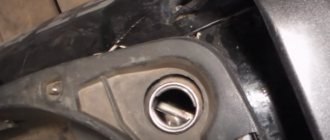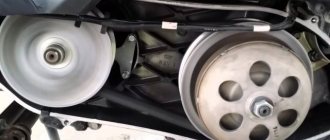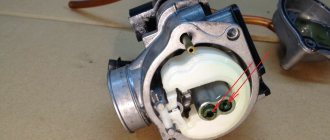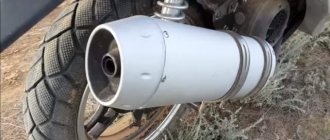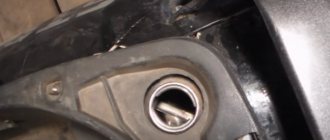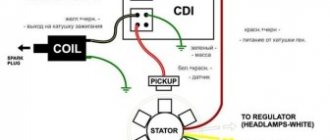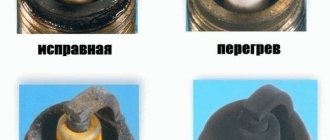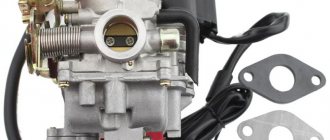Let's imagine this situation. You bought a new 49.9cc scooter and easily accelerate it to 60 km/h, enjoying it. But over time, you notice that you cannot accelerate it to maximum speed. Don't panic right away. The sooner you notice this, the easier and cheaper the repair will be.
If the scooter's engine lacks power, do a visual check. To do this, start the scooter and add a little gas to observe. If the engine revs poorly, there may be several reasons:
- clogged air filter;
- the spark plug is faulty;
- clogged gas filter or carburetor;
- clogged muffler;
- faulty starting enrichment;
- clogged or leaking rubber gas and air pipes leading to the gas valve and carburetor.
- transmission malfunction;
- piston wear;
Let's look at the reasons and start with the simplest. After each action, it is necessary to start the engine and check it for changes in operation.
1. First, check and clean the air filter. Many people do not pay special attention to this detail, and this is a big mistake. The filter is one of the most important parts of the scooter and requires special care. How to clean the air filter, read the article Air Filter Maintenance .
2. If this does not help, then check the spark plug. We unscrew the spark plug and check for the presence of a spark. Reasons for lack of spark:
- faulty or dirty spark plug;
- broken or shorted wiring;
- broken or “shorted” ignition coil;
- broken or “shorted” inductive ignition sensor;
- faulty ignition switch;
- faulty generator;
We also pay attention to its color and the presence of soot. A normal spark plug has the color of deposits on the insulator (the skirt of the central electrode) light brown or coffee; soot and deposits are minimal. Complete absence of oil traces. Moderate electrode burnout. If the spark plug has a large layer of carbon deposits, a different color, or pronounced traces of oil, then this indicates a malfunction of the spark plug, a malfunction of the piston system or the fuel system. It is better to replace the spark plug with a new one and check the engine again for speed. There are several reasons for light failure:
- faulty or dirty spark plug;
- over-enriched mixture;
- inappropriate spark plug heat rating;
- problems with the piston - it splashes with oil
3. The next step is to check the compression in the engine cylinder. If there is no compression or low (4-6 atm), then here are several reasons:
- faulty reed valve - for 2t engines;
- leakage through the crankcase, for example through the crankshaft seals - for 2t engines;
- burnt or loose valves - for 4t engines;
- torn cylinder head gasket;
- burnt or worn piston or cylinder, or rings;
- crack in the cylinder head.
If we have determined the cause, then we begin the repair. Well, if the cylinder is in complete order, then proceed to the next step.
4. Adjust the carburetor and check the entire fuel system for leaks. For information on how to adjust the carburetor, see the article Adjusting the carburetor.
5. The muffler may be clogged and needs to be cleaned. A clogged muffler causes a lot of problems; usually, after cleaning, the scooter becomes unrecognizable.
6. Another possible reason is wear of the variator belt. If necessary, you need to change the variator belt and it is advisable to replace the variator rollers. For more information on replacing the belt, read the article Replacing the variator belt on a scooter .
Why is the scooter moving slowly?!
The scooter accelerates slowly (poor dynamics) - we are looking for the reason.
First, you need to decide whether your scooter can even have normal dynamics initially. An ordinary four-stroke Chinese scooter with a 49.9 cc piston cannot have normal dynamics in principle. Let me note that we are talking specifically about a real four-stroke fifty-kopeck model. After all, often under the inscription 49.9cc on the cylinder there is hidden a cubic capacity of 62, 72 or 82cc. All this is carefully disguised by the Chinese, it is known for what reasons. Well, they set such a cubic capacity in order to at least somehow compete with Japanese and European manufacturers, because pushing off with your feet at the start will not be to anyone’s taste.
Why is the scooter moving slowly?
If you have a Japanese, European, Taiwanese, Korean scooter, it doesn’t matter, it should accelerate at the level of Lada cars of the Soviet Union, some models easily leave cars far behind, naturally, when accelerating to 60 km/h (we’re talking about scooters with an engine capacity of up to 50cc, cubic airplanes can compete with modern foreign cars). Two-stroke scooters accelerate noticeably faster than their four-stroke counterparts, why this happens was described in articles about these engines, use the search on the site, you will find everything
Therefore, you should not compare these two generations of scooters, there will always be a difference.
The scooter accelerates slowly
So the scooter accelerates slowly. What is this connected with, what can be done and what can be changed? Where to look? Everything in order:
The scooter accelerates slowly: 1) If the compression of your scooter reaches 7 atmospheres, there will be no normal acceleration. To solve the problem, you need to change the piston and rings, and also check the cylinder, maybe it needs to be bored. The higher the compression, the more you can squeeze out of the scooter. What is compression on a scooter and what is used with it, read here.
The scooter accelerates slowly: 2) If the weight of the rollers is not selected correctly, the engine speed during acceleration will be either too high or too low. thus, the belt will rise up the pulley either too quickly (with heavy rollers), preventing the scooter engine from spinning, or too slowly (with light variator rollers). Light rollers contribute to the “over-torque” of the engine; it constantly operates at high speeds and, as a result, does not reach maximum speed, since the belt has already reached a certain level, and the shaft rotation speed is limited by the commutator
Therefore, it is very important to choose the optimal weight for the roller
The scooter accelerates slowly: 3) Wear of the variator rollers directly affects both dynamics and speed
Therefore, it is important to check their condition every season or two. It all depends on the intensity of use of the scooter
The scooter accelerates slowly: 4) If the mixture is rich, the scooter “chokes”, the engine cannot work as efficiently, hence the dynamics drop. The maximum speed may not change. Check the spark plug periodically, ensuring that the spark plug electrodes have a consistent brick color. Black velvety soot indicates an excess of gasoline in the fuel mixture compared to oxygen. This is the so-called “rich mixture”, you need to remember.
The scooter accelerates slowly: 5) If the mixture is poor, a drop in dynamics may not be immediately noticeable. Due to the lack of gasoline in the fuel mixture, the scooter's engine quickly overheats, and after that acceleration becomes sluggish. Immediately after starting the scooter from cold, it can work normally. With a low amount of fuel in the mixture, the spark plug electrodes become white and may even melt if overheated.
The scooter accelerates slowly: 6) If the starting enrichment on the scooter does not work, namely, it is always in the “open” position, we get point 4. The scooter starts up well, at the beginning it works and accelerates well, but as it warms up, the dynamics drop due to rich mixture.
7) If the air filter on the scooter is clogged, the mixture becomes rich, hence again we see point 4, there will be no normal acceleration. Therefore, service the air filter every 500 km.
The scooter accelerates slowly:
We looked at the main reasons for poor scooter acceleration. In addition to these points, less common problems can be identified, such as a malfunction in the commutator, spark plug, braking of brake pads and discs, etc.
If you know for sure that your problem with poor dynamics is not related to the points described above, you can join the discussion in the comments field, or go to the site forum. Good luck with the repair.
Now you know why the scooter accelerates slowly and why the scooter drives slowly.
motoklas.ru
Causes of malfunction
You can determine that the carburetor is overflowing by several signs:
- Condition of the candle. A dirty spark plug indicates a rich fuel mixture, which means high gasoline content. Even a serviceable or new spark plug may not be able to cope with the flow of fuel entering the cylinder and over time it will become covered with soot, will be constantly wet and the engine will stop starting.
- Gasoline leaks through the air filter. Signs of fuel may be found in the air filter housing.
- Gasoline leaks through the float chamber gasket.
It is worth noting that these signs can appear either on their own or after repairs. For what reasons can the carb overflow?
Failure of the fuel valve
The tanks are equipped with vacuum fuel taps with three outlets. One of them is taking fuel from the tank, the other is supplying fuel to the carburetor. The third outlet is intended for supplying a vacuum hose. When a vacuum is created in the engine, the valve membrane begins to pump fuel.
Advice! If the engine does not start after a long period of inactivity (fuel is not pumped in), in order not to wait for the engine to pump it in, you can remove the vacuum hose on the other side of the tap and create a vacuum with your mouth until the carburetor is filled.
Clogged air filter
If there is insufficient air supply, the scooter may also overflow fuel. You can diagnose the filter for air permeability as follows. Simply disconnect the air filter. If the engine now starts to work correctly, then it is necessary to change the air filter. When the carburetor on a scooter without a filter still floods, “dig deeper”!
Locking needle
Briefly about the principle of operation of the float chamber. Fuel enters it, thereby raising the float. The float, rising, lifts the locking needle behind it. When there is enough fuel in the chamber, the shut-off function closes the fuel supply hole.
If the shut-off needle is worn out (the tip or metal body is worn out), then it cannot completely close the supply hole and gasoline continues to flow. The same effect occurs if a speck (grain of sand) gets under the locking needle.
Doesn't develop speed and doesn't pull.
Doesn't develop speed and doesn't pull.
18 Sep 2012, 23:18
In general, the situation is like this: A friend called me and bought a new Alpha 50 cc moped, complete with a 72 cc piston, the mileage is only 30 km (before that it was driving fine and the traction was quite good).
He says it won’t start, there is a weak spark, he asked: before it stalled, he sneezed, shot the muffler into the carburetor - he says “Yes!” I arrived, I believed it at his word (fool), I changed my switch, the second push started with a kick, well, I think it’s in the switch, though the rpm is high 2500, well, okay, I think let it warm up. I warmed up the carburetor, I give it gas, but it doesn’t develop speed and stalls At idle, it doesn't start the first time. Then I think about the spark plug, I change the spark plug for a new one - the same, I unscrew mine, a little better, I try to drive through, but it doesn’t even pull first.
This means that there are all signs of overflow, I remove the carburetor, spin the float chamber, gasoline pours out of it, although as far as I know the level should be exactly at the chamber connector, I check it well just in case, I blow out the jets, bend the float a little (there is no time to measure the level in the float chamber, there is no time) , I check all the balls are in place, the damper also works fine, I assemble it, it started from the second click on the switch (before that, before removing the carburetor, it also started with its switch).
It works a little better, but still not the same, it also stalls after applying gas and does not pick up speed sharply (in general, it is overflowing again), I remove the air pipe and the same story.
I don’t want to install my own carburetor, because... I think with mine it won’t be better at 110 cc.
I asked, did you accidentally overheat it? He says no, he didn’t give a lot of revolutions, and he drove at 2-3, he didn’t even turn on the fourth, I was afraid. And I think it’s difficult to overheat the engine after 30 km, especially if it’s not a “boy” anymore.
Who will advise what? I still think the problem is in the carburetor.
Troits at high rpm
Everything related to scooter repair. BE SURE to indicate the model, unit and symptoms of the malfunction in the title of the topic.
Moderators: MikeLoDeon, -JODA-, Lion
Forum Rules MUST indicate the model, unit and symptoms of the malfunction in the topic title.
Header form: [SCOOTER MODEL] – unit malfunction
Example: [Dio] electric starter does not work.
If the topic concerns general repair issues, the model may not be specified.
The main rule is that the title of the topic should be brief, but as fully as possible reflect its content. Topics whose title does not make it clear at least the approximate essence of the question, such as “AAA!!! Save!”, “I have a problem, tell me,” will be DELETED.
Troits at high rpm
janich » 15 Sep 2007 02:49
it was at stage 6, it doesn’t develop a maximum speed, and it’s very difficult to start a cold one (the spark plug looks like it’s overflowing, but there’s a spark). playing with the jets didn’t lead to anything. I swapped 21 to 17.5 + again a game with jacklers. result -0. in a dark room I noticed that the cap on the spark plug was shooting through - replacement. In general, I replaced the valve + cap + spark plug + a new piston hebo. The trouble remained. That is, the average speed is ok, higher - it immediately triples. Benz enters the carber (in There are no gaps in the filter). I accidentally noticed that if you reduce the gap on the spark plug, it becomes better, but the pain does not go away. In my opinion, the ignition current remains, the feeling that at high speeds there is not enough current. But what exactly is moping?? commutator or rotor/stator?? Does anyone have any thoughts??... I'm already tired...
janich Posts: 11 Registered: Sep 15, 2007 02:33
by cer-berus » Sep 15, 2007 03:19 AM
Usually when you change all the gaskets and seals, then you are very surprised that the scooter starts up when cold from the first push!
cer-berus Messages: 12 Registered: Sep 14, 2007 11:46 pm
Troits at high rpm
janich » Sep 15, 2007 5:28 pm
janich wrote: it was at stage 6, it doesn’t develop a maximum speed, and it’s very difficult to start a cold one (the spark plug looks like it’s overflowing, but there’s a spark). playing with the jets didn’t lead to anything. I swapped 21 to 17.5 + again the game with jets. result -0. in a dark room I noticed that the cap on the spark plug was shooting through - replacement. In general, I replaced the valve + cap + spark plug + a new piston hebo. The trouble remained. That is, the average speed is ok, higher - it immediately triples. Benz enters the carber (in There are no gaps in the filter). I accidentally noticed that if you reduce the gap on the spark plug, it becomes better, but the pain does not go away. In my opinion, the ignition current remains, the feeling that at high speeds there is not enough current. But what exactly is moping?? commutator or rotor/stator?? Does anyone have any thoughts??... I'm already tired...
janich Posts: 11 Registered: Sep 15, 2007 02:33
Fasterpast » Sep 15, 2007 5:50 pm
Reed valve?
The brakes were invented by a coward! ...But the coward was invented by the brakes! I drive: Suzuki Address V50, V100 and SkyWave Type-S 400, 650
Fasterpast Messages: 6371 Registered: Dec 22, 2000 02:00 From: Moscow What it rides on: Powered by Franco-Morini (R)
- ICQ
Old Man » Sep 15, 2007 09:18 pm
play with the air filter...
Women pay in kind!
Old Man Messages: 1023 Registered: May 27, 2005 07:20 pm
janich » Sep 15, 2007 11:59 pm
Fasterpast wrote: Reed valve?
visually everything fits perfectly (stock with carbon fiber), I’ll try to bend it, there’s another one.
The question on the other hand is whether such nonsense could be caused by the switch??? or “it either works or doesn’t work.”
I don't like
1-spark, when the spark plug is removed, you can see that it runs along the electrode, that is, it does not always hit one point (as if the current strength is changing)
and about the filter - what is there to play with?? the same thing is done with jets, the current is adjusted to the incoming air, or am I wrong??
janich Posts: 11 Registered: Sep 15, 2007 02:33
Fasterpast » Sep 16, 2007 00:43
What filter do you have? Federal Tax Service?
The brakes were invented by a coward! ...But the coward was invented by the brakes! I drive: Suzuki Address V50, V100 and SkyWave Type-S 400, 650
Fasterpast Messages: 6371 Registered: Dec 22, 2000 02:00 From: Moscow What it rides on: Powered by Franco-Morini (R)
- ICQ
janich » Sep 16, 2007 01:09 AM
red sponge
janich Posts: 11 Registered: Sep 15, 2007 02:33
by janich » Sep 16, 2007 01:10 am
so the thing is that before, in the same configuration as he is moping now, he then
janich Posts: 11 Registered: Sep 15, 2007 02:33
by janich » Sep 16, 2007 6:34 pm
plugged the valve into another container - don’t care
janich Posts: 11 Registered: Sep 15, 2007 02:33
CrashEr » Sep 16, 2007 7:04 pm
Did you change the spark plug? If so, are you sure they are not fake? What is the heat number? What pipe? Are there any foreign objects in the pipe or in the exhaust in general? Is there a dent in the pipe near the cylinder? Is the enrichment in the carburetor working? You can try to completely drown out his channel. Did you wash the carburetor CAREFULLY and EVERYWHERE (that is, generally everywhere possible)? It would be nice to borrow a working switch from someone to check.
A fully equipped Duke costs the same as two Dreadnoughts, with Dukes being more fearsome and lasting longer. (c) David Lloyd George
CrashEr Messages: 1554 Registered: May 28, 2005 18:53 From: Moscow
- ICQ
janich » Sep 17, 2007 00:52
I changed the spark plug, there were two working spark plugs (both glowed at number eight), one had a long thread and the other had a short thread, both worked (I went to buy a long one on the short one)
ES if I'm not mistaken). pipe C16, cylinder new zero, and the old one is also moping. We tried both carburetors, 17 and 21 (read higher). But with a favor it’s difficult, even very difficult, so I’m asking you
Could it be because of HIM that such nonsense can happen - there is a spark, but not in time / not stable / weak
janich Posts: 11 Registered: Sep 15, 2007 02:33
janich » Sep 19, 2007 10:21 am
janich wrote: I
changed the spark plug, there were two working spark plugs (both glowed at number eight), one had a long thread, the other was short, both worked (I was going to buy a long one on the short one)ES if I'm not mistaken). pipe C16, cylinder new zero, and the old one is also moping. We tried both carburetors, 17 and 21 (read higher). But with a favor it’s difficult, even very difficult, so I’m asking you
Could it be because of HIM that such nonsense can happen - there is a spark, but not in time / not stable / weak
janich Posts: 11 Registered: Sep 15, 2007 02:33
reldev » Sep 22, 2007 4:31 pm
I had a similar experience. I decided to completely disassemble it and noticed that the ground bolt was unscrewed almost all the way! Well, this may not apply to your case if you didn’t unscrew the mass...
reldev Posts: 531 Joined: Jun 26, 2006 3:41 pm
- Website
- ICQ
sick guy » Sep 22, 2007 4:46 pm
I have the same problem, after 50 km/h it starts to trip, they told me that it’s my switch that is strangled. I have dio 34. Is this true? tell.
sick guy Messages: 51 Registered: Aug 22, 2007 3:49 pm
- ICQ
Return to Repair
Who's at the conference now?
Currently browsing this forum: no registered users
How to clean the muffler
With a metal cable, acting like a brush. Convenient, fast, but not for long.
Heat treatment
With a blowtorch or in an oven or barbecue (but then be sure to remove the muffler from the scooter). The muffler warms up as much as possible. With blows, the soot resulting from calcination is shed off, and it is blown out using a compressor. Effective, but the result will look unaesthetic.
Chemical treatment
Dismantle the muffler. Wash with pipe cleaner or other caustic liquid, such as sodium hydroxide. Rinse with clean water. Dry well. The end result is a very high quality one. But it’s long and difficult.
What to do if the variator belt is worn out
Both longitudinal and transverse cracks require replacement of the variator. Moreover, it is better not to delay it in order to avoid serious consequences.
Muffler cleaning
It is easy to replace the variator belt if you do not delay this procedure before the belt fails. If you tighten until the weights fall apart, you will most likely need to completely replace the entire mechanism. It’s cheaper and easier not to delay.
To change the belt, all you need is a gas wrench. But it will be difficult to completely replace the mechanism without special tools.
CONTROL ON THE ROAD
It’s one thing to master the skills of driving a scooter in an empty area, and quite another to join the hustle and bustle of city streets
Need I remind you that while driving, all your attention should be focused on what is happening around you? If all you are doing is trying to control how you maintain your balance, including when turning, then it’s too early to hit the road.
Riders of 50cc scooters have few legal options for positioning on the roadway. They are instructed to drive in the far right lane, as close to the sidewalk or curb as possible. In life it’s different: you have to drive closer to the middle in order, say, to go around potholes or foreign objects... Blindly following traffic regulations and driving at the very edge is dangerous. What if a pedestrian takes a step off the sidewalk? Or will a careless car owner open the door of his car?.. It’s safe to stay in the middle of the right lane or even a little to the left.
You should not trail along in the same lane with a slowly moving truck or bus. And it’s better not to approach them: it gets boring quickly. In addition, it is so easy to miss an open hatch or brick that your “leader” missed between the wheels.
The difficulty of driving through city intersections is not even heavy traffic, in which it is difficult to maneuver. Multi-level interchanges in modern cities, tricky lane layouts, prohibitory traffic light signs - all this baffles even an experienced driver. Learn by heart difficult sections of the route on frequently repeated routes, master the algorithms for driving through intersections and junctions.
Law-abiding scooter riders are required to remember the restrictions prescribed for them (the main one is the prohibition of left turns on a multi-lane street). Let's hope that the outdated rules will be rewritten to take into account the increased capabilities of scooters, but until then, let accumulated experience and common sense become guides and good advisers when riding.
Inspection procedure and repair methods
If the scooter does not travel more than 40 km. h., then there is a certain procedure for checking and searching for causes. Accordingly, for each reason there is its own algorithm for repair work.
First of all, the spark plug is checked. To do this, you need to unscrew it and inspect it. If the contacts are clean, then everything is in order. If they are covered with black soot or, on the contrary, they are clean but have a red tint, then there is a problem with the mixture. Repair in this case consists of cleaning and servicing the carburetor.
Next, you can check the quality of the spark on the spark plug and, if it is weak, you need to check the contacts on the high-voltage coil, on the inductive ignition sensor and on the ignition switch. The presence of a short circuit in the specified components and breakdowns to the housing are also checked.
The next step is checking the engine. To start with its temperature. If it overheats, it could mean the mixture is too lean or the fuel is bad. This can be eliminated by cleaning the carburetor.
You can measure the compression at the nearest service station, and if it is low, you will have to disassemble the engine and look for a problem in the piston group.
Sequence of repair actions
The main rule for detecting malfunctions and repairing a scooter is to step-by-step eliminate the elements of the system when identifying the causes of a breakdown in any of them. Search and repair, especially when starting from the starter, must be done in accordance with a strict sequence, where the chain may act as the beginning, and the end, for example, if there is or is no spark. It is worth noting that you do not need to immediately run for a new switch for the scooter, first make sure that the generator is functioning perfectly, only after that test the wiring if there is no spark, etc.
BRAKING
There are four types of braking: full - until the scooter stops, working - to slightly reduce the speed, parking - to hold on a slope, and emergency.
If you sharply, strongly press the brake lever, the wheel may lock - it will stop rotating and the wheel will “skid”. Locking the front wheel is dangerous - a fall is almost guaranteed. If the locking occurs at low speed, the rear wheel is likely to lift (the “stoppie” effect) and the scooter may roll over. The “skidding” of the rear wheel when moving in a straight line is not so critical, at least until the wheel begins to move to the side (in such cases they say: the wheel has skidded). If you don’t have time to release the brake in time, you will fall onto the asphalt.
On scooters with a CVT they brake in three ways: only front, only one rear, and simultaneously front and rear. Which one should you start working on earlier and which one should you press harder? It is advisable to brake simultaneously with both or with a slight advance with the rear brake.
Many beginners are prejudiced against using the front brake - they are afraid of turning over or falling. And they are mistaken: when braking, the weight falling on the front and rear wheels is redistributed, but the front one accounts for most of it. Based on this, it follows that the efficiency of one front brake is approximately 30% higher than that of only the rear. To avoid rolling over, avoid pressing the brake lever suddenly. And braking with one rear wheel is justified only on slippery surfaces.
Some people think that the rear brake is not needed at all. And this is a misconception, and a dangerous one at that. When braking with one front brake in a turn and with poor tire adhesion to the road (for example, when there is a little sand on the asphalt), the wheel drifting to the side and subsequent fall is inevitable. Therefore, do not get used to working only with the front one.
Using both brakes at the same time reduces stopping distance by 20%. When braking from a speed of 30 km/h, modern scooters stop after an average of 5–7 m.
Don't forget that you can't slow down the engine on a scooter. This means that on descents you will have to use the brakes constantly. When driving around the city, this feature does not cause any difficulties, but on long, steep descents it’s a different matter. This means that as a result of constant long-term operation, the brakes may overheat.
Alpha moped does not gain momentum
Many owners of Alpha brand mopeds are faced with a lot of troubles, because depending on the year of manufacture, a 4-stroke engine can operate at different rates. The technology, as you know, is Chinese, and therefore the engine will sooner or later make itself felt, quite standard breakdowns and unstable engine operation will begin. Repairing such mopeds is quite simple and inexpensive, so if you have minimal knowledge, we recommend carrying out repairs yourself. One of the most common breakdowns is when the moped does not pick up speed and the owner of the motorcycle does not know what to do, traffic stops.
The first step is to find the cause of the breakdown, because it is possible that the moped will break down again in the future. When Alpha does not gain momentum, other unpleasant symptoms will result:
- significant loss of power;
- difficult engine starting;
- increased fuel consumption;
- The engine runs unstably, with fluctuations.
Spark plug
The repair procedure is quite simple, the first thing you need to do is get into the engine and find the unit that has failed. Experts point out that a frequent case of breakdown is a faulty or damaged spark plug, so the first thing we do is remove it. Carefully examine the spark plug for defects and other damage; a working spark plug should produce a spark and do so correctly. To check, just insert the spark plug into the “cradle” and lean it against a metal surface. Then turn on the ignition and pull the kickstarter, a spark should form on the spark plug. The absence of a gap and the presence of a huge amount of soot can also be considered a defect in the spark plug. If the reason is the spark plug, change it and try to drive again. If the alpha moped does not gain momentum even after changing the spark plug, move on to the next probable cause.
Carburetor
The carburetor is cleaned regularly, so most Alpha mopeds have already disassembled the carburetor, thereby changing its original settings
As you know, any manufacturer provides its own data regarding the settings of the carburetor of a certain model, so it is important to make this adjustment. Cleaning the carburetor is a fairly simple but important procedure; our website has a detailed description of this process
The carburetor should be blown out, washed and completely cleaned of foreign debris.
Moped does not gain speed under load
In the case of a high load, a malfunction may occur, as a result of which the moped does not gain momentum. The moped owner will immediately have to look at the gas distribution mechanism, that is, the valves. Parts such as valves are located in the cylinder area, so if you often notice an extraneous and unpleasant sound from the cylinder, there is most likely a problem in the gas distribution system.
The cause of such a serious breakdown could be an insufficient air supply, and often the air filter has a hole through which air passes. In the absence of special skills, the best solution would be to contact a specialist; repairing the gas distribution system is almost impossible. In this case, experts advise buying a new air filter or a complete gas distribution unit. The replacement process occurs as follows: the old head is removed, a new part is put in its place, and the valves and clearances are adjusted.
Conclusion
Now we know why the moped does not gain momentum; the reasons, as you can see, are simple, but require certain skills. If your Alpha moped does not gain speed, the reasons for this will be a broken spark plug, a malfunctioning carburetor or a faulty gas distribution unit.
How to check the spark
- Place the spark plug on the metal body of the engine and turn the starter.
- We replace the faulty spark plug.
- It is possible that the spark plug is working properly, but the spark is not produced. We check the wiring and find a break or faulty element.
Possible reasons for lack of spark:
- spark plug contamination or malfunction;
- wiring is broken or of poor quality;
- a broken or simply high-quality coil in the ignition system;
- the induction ignition sensor is broken or “shorted”;
- the ignition switch is faulty;
- generator is faulty.
Why does the moped not gain momentum?
Alpha moped does not rise
What if a moped's four-stroke engine doesn't work?
Motorcycle technology is more widespread now than ever, but it doesn't take your breath away as this vehicle is very comfortable and economical. This is not surprising, but even the usual type of equipment often breaks down, and the owner does not know how to repair his two-wheeled stallion. A very common problem is inconsistency in engine operation, which occurs from time to time at one time, and in some cases after the intervention of an inexperienced owner. In any case, you can fix the breakdown without outside help, without visiting a special workshop where you need to carry out careful repairs, even if the breakdown itself is minor. As annoying as it may be, repair shop owners often jump at the chance to scale up to squeeze more revenue out of a motorcycle. Therefore, it is better to learn how to maintain your own transport without outside help, which will not only save you money, but also allow you to carry out repairs and maintenance.
Possible premises Why the moped does not rotate and does not fix
If you encounter such a problem and do not understand why the moped does not pick up, then the cause of the malfunction must be calculated. In fact, there are many circumstances where the engine cannot reach 100% speed, resulting in severe power failure, inconsistent engine performance, poor starting, increased fuel consumption and other disadvantages due to insufficient engine speed.
Why does the scooter gain momentum poorly?
A very common and often discussed problem on the forum is that the scooter does not pick up speed well. Let's consider the main areas that can contribute to this and a number of solutions that will help prevent this disaster in the future.
As you know, a scooter engine can realize full power only with a properly configured intake system, and if the engine is a two-stroke, then also with an exhaust system. As a rule, if the compression is normal, the whole problem with a sluggish set of revolutions lies precisely in the intake or exhaust. For a two-stroke engine, an important parameter can be considered the geometry of the purge channels and cylinder windows, and the presence of carbon deposits here. Let's take a closer look at a number of key points:
Conclusions: if the scooter engine (two-stroke) does not pick up speed well, we clean and adjust the carburetor, check and, if necessary, clean the muffler and combustion chamber (primarily the purge channels and windows) from carbon deposits. The problem is solved quickly, naturally, if the piston is not worn out and is still ready to ride.
You can also read other articles on the topic:
In most cases, the candle is to blame
Yes, yes, most often the answer to the question of why the scooter does not gain momentum and stalls is the spark plug.
As a result of using low-quality fuel, the gap between the electrodes of the spark plug is filled with carbon deposits. Because of this, spark formation deteriorates, or it cannot form at all. In some cases, too small a distance between the electrodes leads to the formation of a short circuit between them.
In order to get rid of problems, it is necessary to periodically remove carbon from the spark plugs, and also use a feeler gauge to check the size of the gap between the electrodes. For two-stroke engines, the gap is 0.6 to 0.7 mm.
Owners of motorcycles in Kyiv, who often purchase scooters through the website https://dvako.com.ua/, have learned to clean the spark plug without removing it from the cylinder, simply periodically increasing the engine speed to the maximum. You can also file down the side electrode (its end should only reach the middle of the central contact) without changing the distance between the electrodes. This approach allows the spark plug to operate more stably even when carbon deposits form. But you should not remove part of the electrode if almost no carbon deposits are formed.
FAQ: Why does the cold one move, but the hot one stalls?
Everyone wants their equipment to ride well and do it in any conditions, but many people paid attention to the fact that when it’s cold, the moped rides much better than when it warms up. I, just like many now, was puzzled over this question and understanding of its essence did not come immediately...
Physics.8th grade
Everyone studied in the eighth grade, at least those who were interested in the pressing issue. All bodies and gases expand when heated, and the lower their initial temperature, the greater their expansion coefficient will be when heated to a certain temperature relative to the initial one.
Intercooler or nitrous oxide injection
Almost everyone knows about nitrous oxide, everyone has watched super-sophisticated children's films like “The Fast and the Furious” (by the way, the real name of the movie is “Fast and Fierce”, but marketers don’t give a damn about the correctness of the translation. Author’s note), fewer people know about the intercooler, but about the principle of operation Few people even know both systems. So what am I talking about?
Almost the essence
Everyone thinks that nitrous oxide is something really fucking flammable and when it burns it releases an equally crazy amount of heat and energy. Anyone who thinks that way, go back to school, only this time to chemistry class. Bullshit! Nitrous oxide creates an environment for combustion, or rather, it just cools the fuel-air mixture to fairly low temperatures and, in addition, by disintegrating at high temperatures, it releases an additional portion of oxygen.
An intercooler does almost the same thing: it’s a kind of refrigerator that simply greatly cools the atmospheric air before it enters the combustion chamber. That’s all.
Have you noticed that in cold weather the moped really stalls, but in the heat it drives rather mediocre?
The essence
So, what exactly is the whole point? It is that while the engine is cold, firstly, an additional portion of gasoline is supplied to it for a cold start, and secondly, IT IS COLD, and the air does not heat up against a cold engine.
Ask: well, why doesn’t a hot engine drive so well? It doesn’t drive because even before the fuel-air mixture ignites, it manages to heat up in the engine itself and pre-expand to some extent, which is completely unnecessary and out of place, well and plus to everything, the enrichment channel has already closed, which no longer provides additional. portion of gasoline and air.
I had one fuckmobile for repairs: Suzuki Address V, and so it didn’t want to start at all, and after various attempts to correct the situation, I took it and simply unscrewed it and threw out the jet on the enrichment channel. I never thought that the moped, however It’s more of a crappy Suzuka, maybe it can drive like that. It’s true that she ate accordingly...
pitstopsaki.com
Why does the idle speed float?
Engine idle control is broken
Most likely, due to some factors, the regulation was carried out towards a leaner fuel mixture at idle. Adjust the idle speed using the “quantity” and “quality” screws of the fuel mixture.
The channels and/or jets of the carburetor idle system are clogged
The fuel mixture becomes lean. Remove the idle air system fuel nozzle. Clean it, wash it with fuel, blow it with compressed air. If it is deformed or its markings do not match the required ones, replace it.
Foreign air leaking into the carburetor
In this case, the fuel mixture is depleted of excess air. The engine is tripping.
Low or, on the contrary, very high degree of fuel in the carburetor float chamber
The fuel mixture again becomes leaner or, on the contrary, becomes very rich, flooding the spark plug. It is necessary to check and adjust the fuel level in the carburetor float chamber. In addition, you should pay attention to the integrity and position of the floats, and also check the needle-shaped valve, since the size of the fuel level in the float chamber and the subsequent mixture formation directly depend on them.
Scooter air filter clogged
The degree of contamination of the air filter should be quite high, for example, as in the photo. Change the filter element.
Other reasons why the moped stopped moving:
The air filter is clogged, if you have driven more than 2000 km, then cleaning the air filter should help. Check the valves, if they are underpressed or pinched, so as soon as you start adding gas, the moped will lose speed. If the moped has lost power after running in. This means that you need to reconfigure the carburetor, because during break-in all parts are ground in, the compression ratio in the engine may increase and the engine will operate differently. The throttle cable may also stretch; if you realize that there is no click when unscrewing sharply, then you need to tighten the cable or replace it. If you are riding a moped, you give more gas, the revolutions begin to rise, the engine howls, but the moped itself does not move.
Then on a moped the clutch slips. Another common problem why a moped starts to stall is overheating. Another reason why the moped does not pull is that the valves begin to leak or the rings allow oil into the combustion chamber, then the moped will also begin to lose power. Be sure to pay attention to the condition of the chain and sprockets, if they are worn too much - this gives additional load during rotation, so the loss of power may depend on what is heating the chain. Also check the brakes to see if they are jammed, place the moped on the center stand and spin the wheel by hand; if it spins smoothly, then the brakes are fine. And keep an eye on your tire pressure
So if your moped has lost power and stopped pulling, then take it and check everything in every detail.
Operating rules
Any manufacturer includes an instruction manual for their product. It describes when and how the scooter is serviced, how its correct operation is checked (ignition, gear shifting, engine compression and exhaust systems). If the scooter does not pick up speed, then this is primarily due to violation of these instructions. That is, you need to regularly change spark plugs, belts, oil, air filter, and monitor the quality of gasoline and oil. It is necessary to clean the contacts of the electrical system and change the battery on time. Maintenance is not only wiping the scooter from dust, but an in-depth diagnosis of all its components and mechanisms.
Why does the scooter not reach maximum speed?
Let's imagine this situation... You bought a new 49.9 cc scooter and easily accelerate it to 60 km/h, enjoying it. But over time, you notice that you cannot accelerate it to maximum speed. Don't panic right away. The sooner you notice this, the easier and cheaper the repair will be.
If the scooter's engine lacks power, do a visual check. To do this, start the scooter and add a little gas to observe. If the engine revs poorly, there may be several reasons:
- clogged air filter;
- the spark plug is faulty;
- clogged gas filter or carburetor;
- clogged muffler;
- faulty starting enrichment;
- clogged or leaking rubber gas and air pipes leading to the gas valve and carburetor.
- transmission malfunction;
- piston wear;
Let's look at the reasons and start with the simplest. After each action, it is necessary to start the engine and check it for changes in operation.
1. First, check and clean the air filter. Many people do not pay special attention to this detail, and this is a big mistake. The filter is one of the most important parts of the scooter and requires special care. How to clean the air filter, read the article Air Filter Maintenance.
2. If this does not help, then check the spark plug. We unscrew the spark plug and check for the presence of a spark. Reasons for lack of spark:
- faulty or dirty spark plug;
- broken or shorted wiring;
- broken or “shorted” ignition coil;
- broken or “shorted” inductive ignition sensor;
- faulty ignition switch;
- faulty generator;
We also pay attention to its color and the presence of soot. A normal spark plug has the color of deposits on the insulator (the skirt of the central electrode) light brown or coffee; soot and deposits are minimal
Complete absence of oil traces. Moderate electrode burnout. If the spark plug has a large layer of carbon deposits, a different color, or pronounced traces of oil, then this indicates a malfunction of the spark plug, a malfunction of the piston system or the fuel system. It is better to replace the spark plug with a new one and check the engine again for speed. There are several reasons for light failure:
- faulty or dirty spark plug;
- over-enriched mixture;
- inappropriate spark plug heat rating;
- problems with the piston - it splashes with oil
3. The next step is to check the compression in the engine cylinder. If there is no compression or low (4-6 atm), then here are several reasons:
- faulty reed valve - for 2t engines;
- leakage through the crankcase, for example through the crankshaft seals - for 2t engines;
- burnt or loose valves - for 4t engines;
- torn cylinder head gasket;
- burnt or worn piston or cylinder, or rings;
- crack in the cylinder head.
If we have determined the cause, then we begin the repair. Well, if the cylinder is in complete order, then proceed to the next step.
4. Adjust the carburetor and check the entire fuel system for leaks. For information on how to adjust the carburetor, see the article Adjusting the carburetor.
5. The muffler may be clogged and needs to be cleaned. A clogged muffler causes a lot of problems; usually, after cleaning, the scooter becomes unrecognizable.
6. Another possible reason is wear of the variator belt. If necessary, you need to change the variator belt and it is advisable to replace the variator rollers. For more information on replacing the belt, read the article Replacing the variator belt on a scooter.
If you have a Chinese scooter of 50 cc, then check that you really have 50 cc. Often Chinese engineers install a piston engine not of 50 cubic meters but up to 80. This does not cost more and the scooter has better dynamics and maximum speed. But it happens that a Chinese scooter has 150cc, but it cannot accelerate more than 70 km/h. Such scooters are not supplied to Europe through strict controls, but successfully enter the countries of the former USSR.
Checking compression in the cylinder
If the scooter engine does not pick up speed, but everything is in order with the carburetor, you need to check the cylinder compression.
The compression diagnostic process will help assess the condition of the cylinder-piston group without disassembling it. As a rule, damage to the piston rings occurs with reduced compression. For four-stroke engines, it may also mean that the valves are not tightly seated in the seats.
Compression is measured with a compression gauge, which can easily be replaced with an ordinary pressure gauge with a check valve. The compression gauge is mounted in place of the spark plug in the cylinder. To purchase it, you can visit any auto store, it’s inexpensive.
The condition of the cylinder-piston group will help evaluate the compression diagnostic process
Possible reasons for low compression (less than 6 atm) or its absence:
- non-working reed valve - for 2 tons of engines;
- leakage through the crankcase, usually through the crankshaft seals - for 2 tons of engines;
- severely burnt or insufficiently tight valves - for 4 tons of engines;
- damaged cylinder head gasket;
- burnout or wear of the piston, cylinder or ring;
- microcracks in the cylinder head.
Motorcyclist
The most common reason is a worn clutch, then a worn variator belt, worn variator rollers, a worn clutch spring, and the variator itself can also be worn out. The most dangerous thing is examining and replacing the variator. On most scooters, the nut that secures the CVT is unscrewed clockwise; Do not unscrew it with a bolt gun under any circumstances, because you can break the crankshaft thread (then you get a lot of money: crankshaft from 3000 rubles + work to replace it with engine overhaul)
There are, but less frequently, other causes of breakdowns. In the event of such a breakdown, getting into the engine is the last thing; at least first measure the pressure in the cylinder with a compression gauge (at the same time check the spark plug). It happens that the carburetor is clogged, as well as the exhaust pipe (in the latter case, a scooter that accelerates to 60 km/h has difficulty accelerating to a maximum of 20 km/h). As for a clogged exhaust pipe, either the pipe is replaced, or the removed pipe is placed in a fire, heated, and then the soot is shaken out of it. Another method is possible (if you know a welder): a thick part of the pipe is sawed with a grinder (lengthwise), the soot is shaken out, then the pipe is welded.
loss of speed when driving
#1 OFFLINE serg83
- User
- 7 messages
- 0 I'll go
- Name: Sergey
- Yoshkar-ola city
- Wheels: nexus x1
Post edited by serg83: 28 March 2012 – 02:21 PM
#2 OFFLINE Nahlebnik
User 2502 posts 2 I'll go
- Name: Alexander
- Moscow city
- Wheels: Suzuki Intruder VL1500 LC
Post edited by Nahlebnik: 28 March 2012 – 02:40 PM
#3 OFFLINE Topotun
SIM drive
1939 messages 0 I'll go
- Tel.: +7 9I5 O2H O7 7Z
- Name: -
- Moscow city
- Wheels: SYM O'eklmn (was). Honda Shadow Aero
nexus x1 equipment? look at the vacuum tube going from the carburetor to the fuel pump - if there is even a smell of gasoline in it, change the fuel pump. Another question: is everything okay with the membrane in the carb? Is the damper not sticking?
In general, according to the symptoms, the problem may not be in the supply of gasoline or air, but in the electrics (coil, switch)
Post edited by Topotun: 28 March 2012 – 04:20 PM
SYM CLUB
3167 messages 0 I'll go
- Name: Oleg
- Moscow city
- Wheels: Honda CN 250, SsangYong Korando 2.3 TD
#5 OFFLINE BadCat
Organizer
8178 messages 6 I'll go
- Tel.: +7 9Ib Zb9 9I Z8
- Name: Dmitry (Cat)
- Lyubertsy city
- Wheels: VFR1200X Crosstourer
There is no need to drive faster than your guardian angel flies.
#6 OFFLINE serg83
User 7 messages 0 I'll go
- Name: Sergey
- Yoshkar-ola city
- Wheels: nexus x1
Can you give more details? It is very difficult to assess the color of soot from such a description. The normal color of soot on a spark plug is described as “The center electrode skirt is light brown in color with minimal soot and deposits.” Well, not chocolate at all. Maybe the mixture is too rich?
Checking and cleaning the air filter
When the air filter is clogged, the air flow into the carburetor is greatly reduced, which leads to an over-enrichment of the mixture with gasoline, as well as increased fuel consumption, loss of power at the bottom, and increased formation of soot in the combustion chamber. This is the most common reason why a started scooter does not gain momentum.
Removing the filter
If we detect unstable operation of the scooter, first of all we check the air filter:
1.Remove the filter, carefully removing along the way all parts that interfere with this process
2. We clean the filter housing from dirt.
3. Dismantle the housing, being careful not to damage it.
4. We check for damage: through holes, cracks, tears, insufficient adherence to the cover or edges of the case.
5. Carefully remove the filter from the lid.
6.If the filter is damaged or its service life has been exceeded, then simply install a new one in its place. There is no point in wasting time trying to restore it; it is not economically feasible.
Cleaning the filter
Ways to clean the scooter air filter:
- Washing the filter in gasoline. Gasoline changes occur at least 2 times. Complete drying is not required.
- Rinse the scooter's air filter in water using ordinary detergents intended, for example, for washing dishes, and then dry until completely dry. Drying should be natural, without heating.
We saturate the filter with oil
After washing and drying the filter, it must be impregnated with a special impregnation or engine oil. This will save your carburetor and CPG from small dust particles that may remain on the surface of the filter. Without oil impregnation, the functionality of the filter is extremely low, so the ENTIRE surface of the filter must be covered with a thin but visible layer of oil.
If you use a special impregnation, it is enough to cover the entire surface with a thin layer. Even the smallest dust particles stick to this liquid.
Or you can just get by with regular motor oil. But the use of special impregnation is more effective.
Reinstall the filter.
Scooter carburetor clogged
Another important point is that the jets and channels of the scooter’s carburetor are clogged. In this case, as stated in many articles, normal starting and stable idle operation are unlikely. Of course, in this case, you need to remove the carburetor and blow out the jets and channels with a special liquid. The jets must first be unscrewed. Don't forget also about the channels of the starting enrichment. We looked at how to properly clean a scooter carburetor here.
In the Liqui Moly product line there is such a product - Motorbike Luft-Filter-Oil. This is an ultra-sticky liquid synthetic composition for impregnation of reusable porous filter materials. It is necessary in order to improve the collection of dust and sand. That is, the principle of operation is almost the same as that of a fly catching tape. Despite its super stickiness, Motorbike Luft-Filter-Oil does not impair the passage of air through the foam rubber, but prevents the penetration of abrasive and water through the filter. The composition is optimal not only for servicing standard and tuned air filters of scooters, but can also be used for cross-country motorcycles.
The life of the engine hangs by a thread
We sorted out the filter. Now let's move directly to scooter engines, which come in two types: 2-stroke and 4-stroke. The Achilles heel of “two-stroke” engines is the oil pump, which pumps oil from a special tank in small doses into the carburetor, where it is mixed with gasoline, after which the mixture enters the combustion chamber. The oil pump is driven by a cable directly connected to the throttle handle (the more you unscrew the handle, the greater the performance of the oil pump).
The starting enrichment is faulty or does not work
The second reason is that the starting enricher does not work. For normal starting of the scooter engine when cold and stable operation at idle before it warms up, the carburetor must prepare a slightly enriched mixture compared to normal operation. The mixture is enriched by opening an additional fuel channel using an automatic starting enricher. In fact, the role of the starter booster is often underestimated by scooter riders and this point is overlooked. If there are no problems during a hot start, but during a cold start and stable operation after starting is difficult, the carburetor is still clean and the compression is normal - be sure to look at the starting enrichment. How to check it was described in detail in this article.
Checking the spark plug
The condition of the spark plug provides a lot of information for understanding the causes of the malfunction and, accordingly, for choosing repair actions.
Acceptable view
The appearance is light, slight precipitation or electrocorrosion is possible.
To understand the causes of a malfunction, the condition of the spark plug provides a lot of information.
Carbon deposits on the candle
Recommended actions:
- adjustment of the working mixture;
- adjust the cold start system of the scooter engine;
- replace the air filter;
- Cleaning the spark plug or replacing it with a new one. In this case, it is important to select the correct heat number.
Overheat
Recommended actions:
- change the torque of the scooter's spark plug;
- debug the scooter engine cooling system;
- understand the ignition system;
- understand the glow number of the spark plug (a value characterizing the spark plug, proportional to the average pressure at which glow ignition begins to appear during testing of the spark plug on a motor calibration unit).
Carbon deposits on the spark plug may cause the scooter to malfunction.
Oil contamination
Recommended actions:
- change the ratio of gasoline and oil in the fuel mixture, replace the spark plugs of the scooter (for two-stroke engines);
- Check the condition of the scooter engine; you may have to repair it.
In general, it is believed that if a Chinese scooter does not start well and does not gain momentum, then, unlike European and Japanese scooters, the problem is most often in the ignition system.
